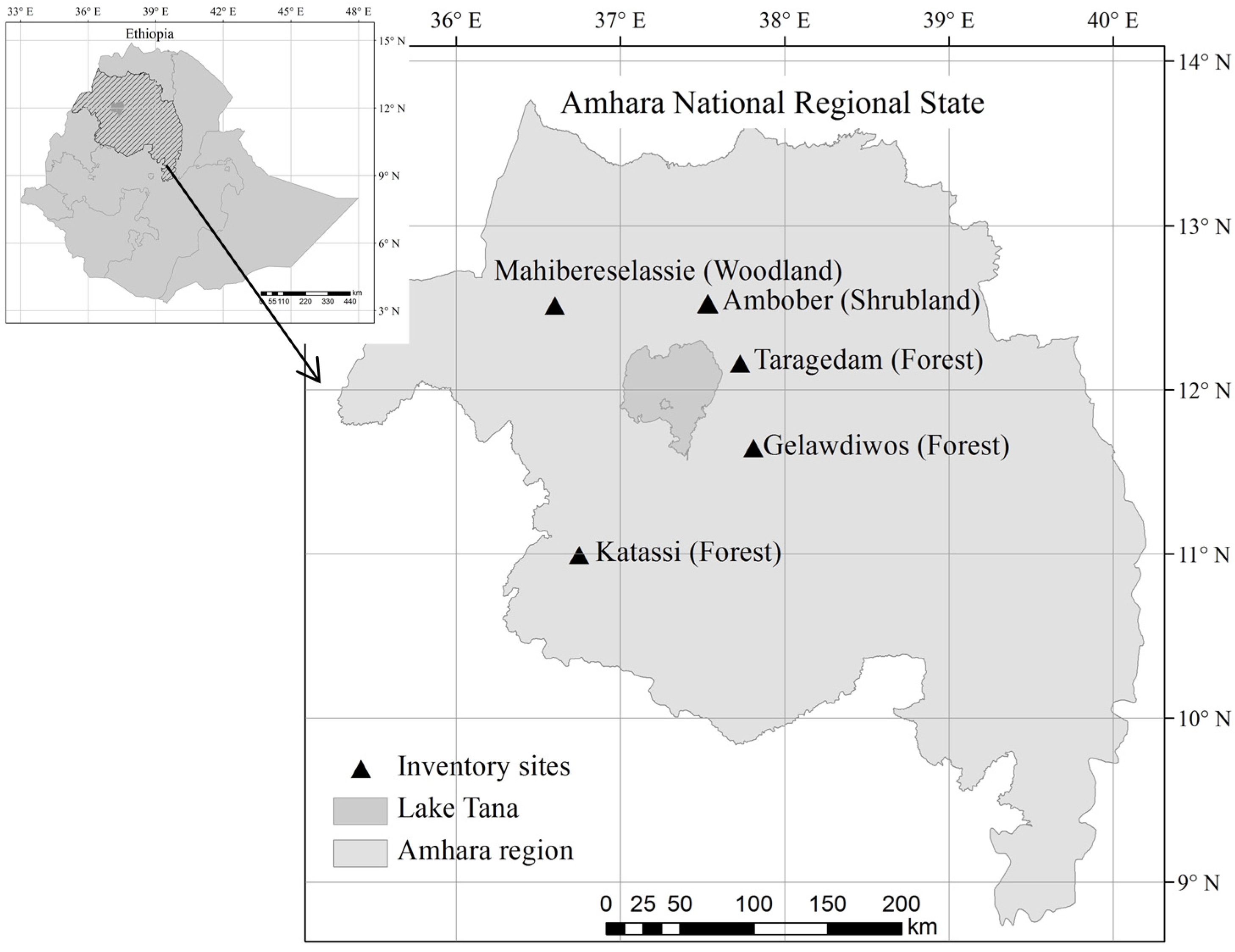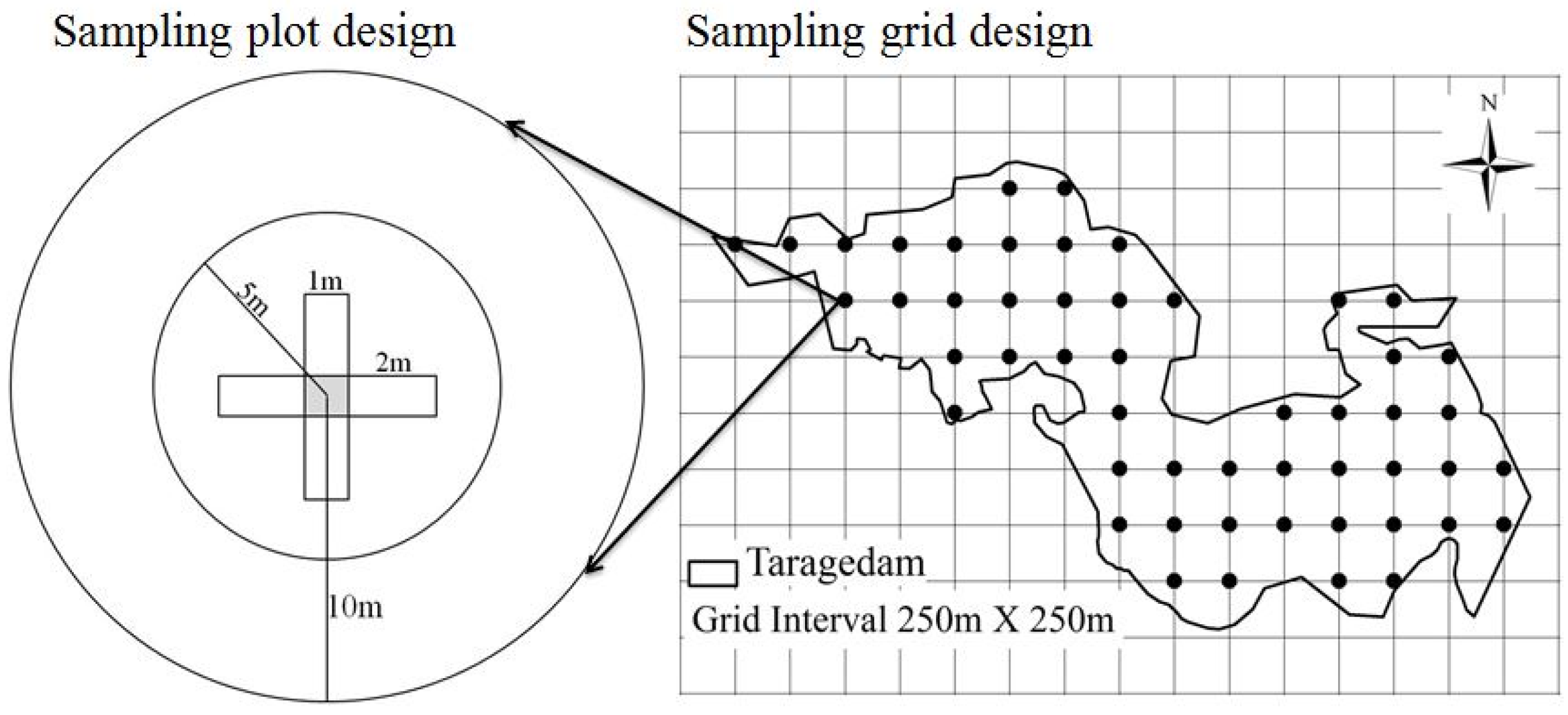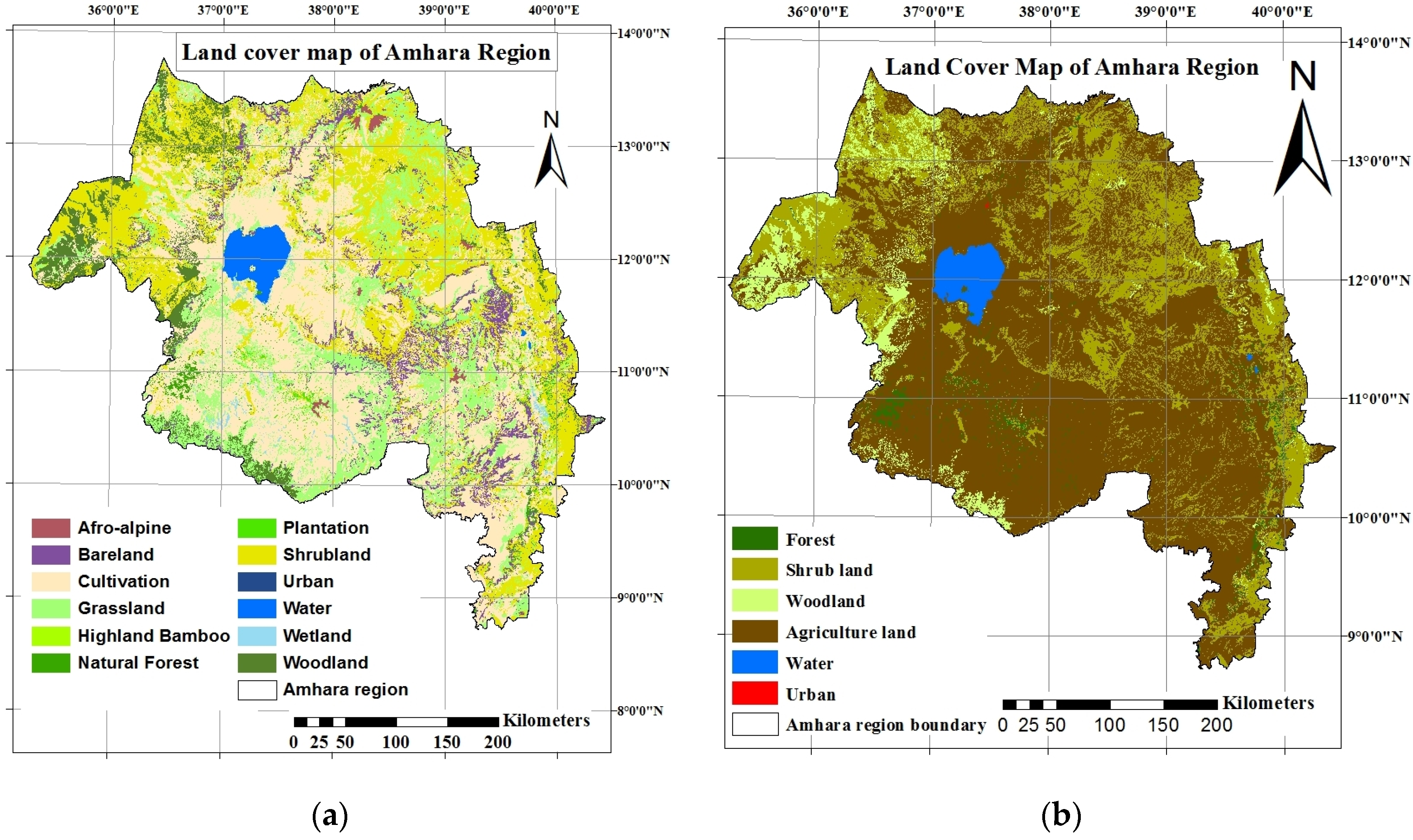2.1.1. Study Area
The Amhara region, in northwestern Ethiopia, has a land area of 15.7 Mha, of which one-third is covered with woody vegetation. For our analysis, we selected study areas covering different agro-ecological zones with typical vegetation types: (i) forests, (ii) shrubland/exclosure, and (iii) woodland.
The selected study areas and vegetation types are Ambober (shrubland), Gelawdiwos (forest), Katassi (forest), Mahibereselassie (woodland), and Taragedam (forest) (
Figure 1).
Even though the regional and/or local governments declared these forests as protected, human activities and cattle grazing are still active and common. The Mahibereselassie woodland has the highest cattle population and agricultural activities. The Ambober exclosure is guarded and protected since its establishment in 2009. Human and animal activities are minor at the Gelawdiwos and Katassi sites. The Taragedam forest has a minor anthropogenic disturbance history [
18]. The most common types of human activities occurring within these forest areas are cutting and harvesting trees for energy, production of different household and farm implements and clearing for agriculture and grazing activities [
23].
2.1.2. Sampling Technique
Our five study regions (see
Figure 1) cover the main ecological zones of the area and differ in size: the largest area is the Mahibereselassie woodland with 19,162 ha followed by the forest areas in Katassi (553 ha), Taragedam (324 ha) and Gelawdiwos (68 ha). The Ambober shrubland/exclosure covers 6 ha.
The decision on the grid size, and thus the number of sample plots was derived based on statistical principles by achieving a minimum number of inventory plots. After a number of pilot studies in the different forest inventory areas and test calculations, we defined the following grid size by study region: for the Mahibereselassie woodland area, a 3 km by 3 km grid size with 21 sampling plots was established. For the forest areas in Katassi, a 300 m by 300 m with 63 sampling plots; Taragedam 250 m by 250 m with 52 sampling plots; and for Gelawdiwos, 250 m by 250 m with 34 sampling plots were established. For the Ambober shrubland/exclosure, a 50 m by 50 m sampling design with 28 sampling plots was established. This resulted in a total number of 198 sampling plots. A typical example (Taragedam) is given in
Figure 2. The data collection was carried out during the summer 2014 (July to September).
Each sample plot consists of two concentric circles and four rectangular plots (1 m × 2 m) (see
Figure 2). The plot area was corrected as a function of the slope angle [
4]. The radius of the larger circle records all trees with a DBH ≥ 10 cm and exhibits a radius of 10 m for the study areas in Gelawdiwos, Taragedam, and Ambober and 15 m for Katassi and Mahibereselassie. For each tree found within the specified radial range, we recorded the tree species, diameter at breast height (DBH) in cm, and the tree position on the plot.
One of the important goals of the study is to derive annual growth information. Since we have no repeated tree records, increment cores are taken according to the following procedure: Based on the DBH records on a given sampling plot, we selected the so-called “central” stem or tree—this is the 60 percentile of the DBH distribution—on a given sampling plot. We follow here a procedure suggested by [
24], which showed in their studies that the “central” stem represents the “mean” tree (=quadratic mean DBH) on a given plot, and cuts the basal area in two equal halves. The “mean” tree dimension is derived from the per hectare values, e.g., the tree represents the quadratic mean DBH (basal area divided by the stem number/ha) and consequently approximately the average volume (volume/ha divided by the stem number/ha). Thus, the growth rates of the “central” stem (60 percentile of the DBH distribution on a given plot) are proportional to the growth rates of the per hectare values assuming that the stem number remains equal for the growth period.
One important precondition of this approach is that each tree ring represents one year. According to Worbes [
25] and Zhang et al. [
26], distinct tree rings are formed in response to annual precipitation pattern. Sisay et al. [
27] confirmed this pattern by showing that the rainy season in the Amhara region is between June and August.
Based on the DBH distribution on a given inventory plot, for each tree species a “central” stem according to the DBH distribution was selected. For this tree, the tree height (h (m)), the height to the live crown base (HLC (m)), and an increment core was taken to derive the ten-year increment rate. Although obtaining full cross-sectional discs may minimize the effect of false and/or missing tree rings [
28], destructive sampling (e.g., cutting trees and taking discs to the lab) is forbidden in the area. Moreover, it is neither a requirement nor is it carried out within the scope of routine inventory data collection [
29].
For each central plot and species-specific “central” stem, an increment core sample was taken towards the plot center at the DBH to address potential slope effects in the tree form (e.g., ellipse). All sample cores were checked for potentially missing tree rings by comparing the increment core with a so-called “standard” [
30], which compares single increment rates of a given core versus so-called “signal” years of the “standard” (>90% of the increment rates increase or decrease versus the previous year). In total, 424 increment cores are available for our study (see
Table 1).
Trees with a tree height >1.3 m and a DBH of <10 cm are considered as saplings and were recorded on the smaller circle with a radius of 5 m. The 5-m radius was applied to all our study areas for recording saplings. Due to the large number of trees, we simplified the design by creating DBH classes ranging from ≤4 cm, 4–6 cm and 7–9.9 cm. We counted all individuals by species and assigned the numbers according to the DBH classes. We selected one representative tree by species and DBH class and recorded the tree height.
All trees with a tree height of ≤1.3 m are seedlings and are recorded on the four 1 m by 2 m rectangular (total 8 m
2) (see
Figure 2). Again, the seedlings were grouped in two classes according to tree height: Group 1 (≤50 cm) and Group 2 (50 cm to 1.3 m). The numbers were recorded by species and height class (
Table 1).
We recorded the DBH for each tree on a given plot but only the tree height from the central trees. This is a common procedure within routine inventory designs to enhance data collection activities especially in difficult terrain [
13,
31,
32]. However, this approach requires DBH–height functions to derive missing tree heights [
31,
33]. We also defined the five most frequent tree species within each study area plus a species group “others” and collected at least 20 trees per species, within the study areas (not limited to the plots) covering the full DBH and height range. The only exception was Ambober, where no DBH–tree height data were recorded because the area was covered with shrubs and thus the trees were too small. The Petterson’s [
34] height–diameter function was chosen to derive missing tree heights:
where
h is the tree height (m) and
DBH is the diameter at breast height (cm),
a0 and
a1 are the resulting parameter estimates. We used R standard software package [
35] to run non-linear regressions. The results are given in
Table 2.
This dataset is used for calibrating species-specific diameter–height functions for deriving missing tree heights. In total, we recorded more than 1154 trees, of which 870 trees cover the 20 tree species, and 284 trees cover the species groups “other trees” by region.
Timber Volume
Based on the results of
Table 2, we calculated the missing tree heights and the corresponding standing timber volume on a given inventory plot. The general formula for deriving standing timber volume for each tree (
V) (m
3) can be expressed as [
24]:
where
f is the form factor addressing the shape of the tree, and all other parameters are as previously defined. Since no form factor functions for the tree species in the region exist, we decided to follow the suggestions by [
36,
37,
38] and use a form factor of 0.5.
Volume Increment
Within sustainable forest management, the assessment of annual volume increment rates is important to ensure sustainable harvesting [
13,
39]. Up until this point, no such information exists for the forest areas in the Amhara region of northwestern Ethiopia. For our work, we have systematically collected increment cores for all our study regions. As outlined in the sampling technique section, these increment cores were taken from the “central” stem (the mean tree which is approximately the 60 percentile of the DBH distribution) by species on a given plot [
24].
After determining the 10-year increment rates (2005 to 2014) with a 0.01 mm precision using the Velmex TA measuring system (Velmex Inc. Bloomfield, New York, NY, USA), the DBH of the “central” stem and inventory plot can be calculated for the year 2005. Applying the DBH–height function (Equation (1)) using the species parameter estimates of
Table 2, and inserting in the volume function (Equation (2)), the corresponding volume in 2005 was calculated.
With this information, the volume ratios by plot and tree species can be calculated as:
where
inci refers to the individual tree volume increment ratio,
V2005
i and
V2014
i are the timber volume derived from the “central stem” in 2005 and 2014, respectively. Since this tree volume increment ratio is equal to the total volume increment ratio of a given plot, we can multiply the total plot volume
V2014 with
inci to derive the plot volume in 2005. With these numbers, we can calculate the 10-year periodic mean annual volume increments (
IV) (m
3·h
−1·year
−1) by inventory plot:
where
V2014 and
V2005 are the tree volumes (m
3) in 2014 and 2005, respectively; 10 is the 10-year increment interval. Dead trees due to mortality are included if recorded.
Aboveground Carbon and Carbon Increment
The aboveground carbon estimations through destructive sampling is the most recommended and accurate method [
40,
41,
42]. Given the small amount of forest resources, the high species diversity and the current forest conservation policy by the state, it is nearly impossible to undertake destructive sampling for the development of allometric functions in Ethiopia as well as for the Amhara region. Thus, we considered existing allometric functions developed for commercial tree species in Ethiopia [
43,
44,
45,
46]. Since Sileshi [
47] has shown that these functions introduce a potential source of uncertainty, especially if applied in a very diverse structured of natural forests, we decided to use the mixed species allometric biomass function developed for tropical forests by Chave et al. [
48], which has the following form:
where
ln(
AGB) is the natural logarithm of the aboveground biomass (kg) and
is wood density (ton·m
−3).
A wood density of 𝜌 = 0.614 ton·m
−3 developed for Africa is used [
49,
50]. A total of 50% of the resulting aboveground biomass (AGB) of Equation (5) provides the final carbon estimates [
51,
52].
Similar to the volume calculation, we calculated the aboveground biomass and carbon estimates for each tree then at the plot level and finally for each study area. Similar to the periodic mean annual volume increment rates, the periodic mean annual carbon increment rates for the period 2005 to 2014 can be derived. Again, we use here the approach of the “central” tree with the corresponding tree dimensions as outlined in the previous section.
Net Primary Production (NPP)
NPP is the amount of carbon remaining and allocated in the plant parts after autotrophic respiration (cellular and maintenance respiration) per growth period [
12,
53,
54]. The growth period is determined depending on the interval between the repeated measurements which usually vary from 5 to 10 years [
12,
55]. We calculated NPP (gC·m
−2·year
−1) as the sum of periodic (2005–2014) carbon accumulation in the fine root turnover, aboveground woody parts and litter fall (Equation (6)) [
55,
56].
where
Cwoody (gC·m
−2·year
−1) is the dry carbon increment of the woody biomass resulting from repeated plot observations between time
2 and time
1.
Cfineroots and
Clitter (gC·m
−2·year
−1) are the carbon flow in to fine roots and litter, respectively.
The annual aboveground dry carbon in the woody part of the tree (
Cwoody) is calculated as follows:
where
g2014 and
g2005 are the tree basal area (m
2·ha
−1) in 2014 and 2005, respectively, 10 is the 10-year increment interval.
C2014 (gC·m
−2) is the aboveground woody dry carbon content in 2014.
For Ethiopia, a reliable model for estimating the proportion of fine root turnover and litter fall does not exist. Malhi [
57] and Raich and Nadelhoffer [
58] found that for a given time period, the proportion of dry carbon turnover through fine roots and litter fall comprises 60% of the total dry carbon accumulation and that the carbon uptake by fine roots and litter is equal. The proportion of the increment of aboveground dry carbon in the woody part of the tree also comprises 40% of the total dry carbon increment. With this information, we assume that the dry carbon increment in the fine roots and foliage turnovers can be calculated from the dry carbon increment of the aboveground woody biomass. For all trees (DBH ≥ 10 cm) and saplings (DBH < 10 cm), the procedure was applied.










